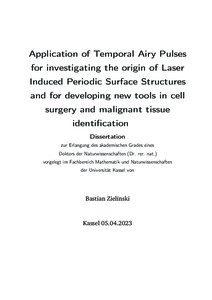| dc.date.accessioned | 2023-07-05T07:39:46Z | |
| dc.date.available | 2023-07-05T07:39:46Z | |
| dc.date.issued | 2023 | |
| dc.identifier | doi:10.17170/kobra-202307048331 | |
| dc.identifier.uri | http://hdl.handle.net/123456789/14870 | |
| dc.language.iso | eng | eng |
| dc.rights | Namensnennung - Weitergabe unter gleichen Bedingungen 4.0 International | * |
| dc.rights.uri | http://creativecommons.org/licenses/by-sa/4.0/ | * |
| dc.subject.ddc | 530 | |
| dc.title | Application of Temporal Airy Pulses for investigating the origin of Laser Induced Periodic Surface Structures and for developing new tools in cell surgery and malignant tissue identification | eng |
| dc.type | Dissertation | |
| dcterms.abstract | In this thesis, ultrashort Temporal Airy Pulses are used to study Laser Induced Periodic Surface Structures (LIPSS) in Part I and to enable the photoinjection of fluorescent markers into single living cells in Part II, Chapter 8. In both cases, the laser pulse excites a dielectric material (fused silica and water) and the special spatio-temporal dynamics of the interaction of a Temporal Airy Pulse with the dielectric is exploited to extend the shape of the excited region along the axis of laser propagation. For the LIPSS, this allows the creation of high-aspect-ratio sub-wavelength holes in a fused silica sample which act as singular sources for the growth of LIPSS. For the photoinjection into cancer cells, the long excited region reduces the need to focus precisely on the cells outer membrane of the cell, but also raises the question of whether this causes more damage inside the cell. In addition, Part II, Chapter 9 will present the identification of cancer tissue by Laser-Induced Breakdown Spectroscopy (LIBS) on biopsy samples from human patients with metastasized cancer. The reader is referred to the topical introductions at the beginning of Part I ‘Investigation of the origin of Laser Induced Periodic Surface Structures with Temporal Airy Pulses’ and Part II ‘Photoporation of cells with single Temporal Airy Pulses and Laser Induced Breakdown Spectroscopy on cancerous tissue’. For Part II, Chapter 8 ‘Optoinjection of fluorescent markers into living HeLa cells with single Temporal Airy Pulses’ and 9 ‘Pathological identification of cancer tissue by laser-induced breakdown spectroscopy (LIBS) and Neural Networks’ provide introduction as well. The technical background Chapters 1 ‘Experimental Setup’, 2 ‘Pulse shaping and characterization of laser pulse parameters’ and the ‘Light and matter interaction’ Chapter 3 contain information relevant to both parts. The Appendix for Part I can be found in A and for Part II in B. | eng |
| dcterms.accessRights | open access | |
| dcterms.creator | Zielinski, Bastian | |
| dcterms.dateAccepted | 2023-05-24 | |
| dcterms.extent | x, 161 Seiten | |
| dc.contributor.corporatename | Kassel, Universität Kassel, Fachbereich Mathematik und Naturwissenschaften, Institut für Physik | ger |
| dc.contributor.referee | Baumert, Thomas (Prof. Dr.) | |
| dc.contributor.referee | Baron, Camilo Florian (Prof. Dr.) | |
| dc.contributor.referee | Garcia, Martin (Prof. Dr.) | |
| dc.contributor.referee | Kusserow, Thomas (Prof. Dr.) | |
| dc.subject.swd | Laser | ger |
| dc.subject.swd | Oberflächenstruktur | ger |
| dc.subject.swd | Laserimpuls | ger |
| dc.subject.swd | Laserinduzierte Breakdown-Spektroskopie | ger |
| dc.subject.swd | Chirurgie | ger |
| dc.subject.swd | Krebszelle | ger |
| dc.type.version | publishedVersion | |
| kup.iskup | false | |
| ubks.epflicht | true | |


